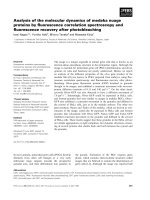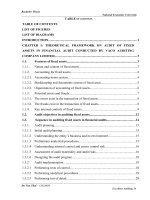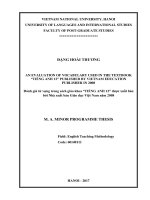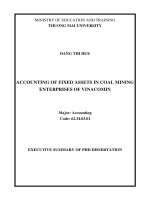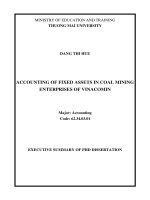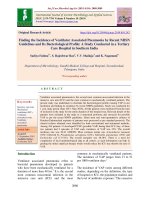COMPLETING THE AUDIT PROCESS OF FIXED ASSETS IN THE AUDIT OF FINANCIAL STATEMENTS CONDUCTED BY VIETNAM VALUATION AUDITING AND FINANCIAL CONSULTING CO.,LTD
Bạn đang xem bản rút gọn của tài liệu. Xem và tải ngay bản đầy đủ của tài liệu tại đây (598.12 KB, 124 trang )
MINISTRY OF FINANCE
ACADEMY OF FINANCE
FACULTY OF ACCOUNTING
----------
GRADUATION THESIS
COMPLETING THE AUDIT PROCESS OF FIXED ASSETS
IN THE AUDIT OF FINANCIAL STATEMENTS
CONDUCTED BY VIETNAM VALUATION AUDITING AND
FINANCIAL CONSULTING CO.,LTD
SUPERVISOR :
FULL NAME
CLASS
STUDENT ID
:
:
:
Hanoi - 2021
ii
TABLE OF CONTENT
DECLARATION.......................................................................................................5
CHAPTER 1: GENERAL THEORY OF THE FIXED ASSET AUDIT
PROCESS IN THE AUDIT OF FINANCIAL STATEMENTS...........................9
1.1. OVERVIEW OF FIXED ASSETS IN THE ENTERPRISE...........................9
1.1.1. The concept of fixed assets........................................................................9
1.1.2. The role of fixed assets in the enterprise and information about fixed
assets in financial statements............................................................................10
1.1.3. Accounting for fixed assets in the business.............................................11
1.1.4. Internal control over fixed assets............................................................17
1.2. OVERVIEW OF AUDIT OF FIXED ASSETS IN AUDIT OF FINANCIAL
STATEMENTS.....................................................................................................18
1.2.1. Necessity and objectivity of the audit of fixed assets in the audit of
financial statements...........................................................................................18
1.2.2. Fixed asset audit objective......................................................................19
1.2.3. Fixed asset audit basis.............................................................................21
1.2.4. Internal control and internal control survey of fixed assets in the audit of
financial statements...........................................................................................22
1.2.5. Common errors in fixed asset audit.........................................................23
1.3. AUDITING PROCEDURES OF FIXED ASSETS.......................................25
1.3.1. Audit planning.........................................................................................25
1.3.2. Conduct audits.........................................................................................30
1.3.3. Finishing the audit of fixed assets...........................................................46
CONCLUSION.......................................................................................................47
CHAPTER 2: THE CURRENT SITUATION OF THE FIXED ASSET AUDIT
PROCESS IN THE AUDIT OF FINANCIAL STATEMENT CONDUCTED
BY VIET NAM AUDIT VALUATION AND FINANCIAL CONSULTING
COMPANY LIMITED...........................................................................................48
2.1. GENERAL OVERVIEW OF VIET NAM AUDIT VALUATION AND
FINANCIAL CONSULTING COMPANY LIMITED........................................48
2.1.1. The process of formation and development.............................................48
2.1.2. Organization management apparatus.....................................................50
2.1.3. Services provided by the Company..........................................................52
2.1.4. General process of auditing financial statements of FACOM................54
2.1.5. Organizational characteristics of audit records.....................................60
2.1.6. Auditing quality control of Vietnam Audit Valuation and Financial
Consulting Company limited.............................................................................63
2.2. THE REALITY OF THE AUDIT OF FIXED ASSET IN FINANCIAL
STATEMENT AUDITING PERFORMED BY VIETNAM AUDIT
VALUATION AND FINANCIAL CONSULTING COMPANY LIMITED......65
2.2.1. Audit planning.........................................................................................65
2.2.2. Implementing...........................................................................................83
2.2.3. Finishing the audit of fixed assets.........................................................100
iii
CONCLUSION.....................................................................................................101
CHAPTER 3: RECOMMENDATION FOR IMPROVING THE AUDIT OF
FIXED ASSETS IN FINANCIAL STATEMENTS CONDUCTED BY
VIETNAM AUDIT VALUATION AND FINANCIAL CONSULTING
COMPANY LIMITED.........................................................................................102
3.1. ASSESSMENT OF THE REALITY OF THE FIXED ASSETS AUDIT
PROCESS AT VIETNAM AUDIT VALUATION AND FINANCIAL
CONSULTING COMPANY LIMITED.............................................................102
3.1.1. Advantages.............................................................................................102
3.1.2. Weakness...............................................................................................106
3.1.3. Reason...................................................................................................109
3.2. THE DIRECTION OF DEVELOPMENT AND THE REQUIREMENT OF
COMPLETING THE AUDITING PROCESS OF FIXED ASSETS IN AUDIT
OF THE FINANCIAL STATEMENTS AT VIET NAM AUDIT VALUATION
AND FINANCIAL CONSULTING COMPANY LIMITED.............................109
3.2.1. The direction of development of Vietnam Audit valuation and financial
consulting company limited.............................................................................110
3.2.2. The necessary of completing the Audit process of fixed assets in Audit of
the financial statement performed by FACOM................................................110
3.3. PRINCIPLES AND REQUIREMENTS FOR FINISHING THE AUDIT
PROCESS OF FIXED ASSETS IN AUDIT OF FINANCIAL STATEMENTS
AT VIET NAM AUDIT VALUATION AND FINANCIAL CONSULTING
COMPANY LIMITED.......................................................................................113
3.3.1. Principles of completing the audit process of fixed assets in the audit of
financial statements at FACOM......................................................................113
3.3.2. The complete requirement.....................................................................114
3.4. SOME SOLUTIONS TO COMPLETE THE AUDIT PROCESS OF FIXED
ASSETS IN AUDIT OF FINANCIAL STATEMENTS AT AT VIET NAM
AUDIT VALUATION AND FINANCIAL CONSULTING COMPANY
LIMITED............................................................................................................114
3.4.1. Solutions to improve the financial statement audit process at Vietnam
Audit Valuation and Financial Consulting Co., Ltd........................................114
3.4.2. Solutions to improve the fixed asset auditing in the financial statement
audit process at Vietnam Audit Valuation and Financial Consulting Co., Ltd
.........................................................................................................................116
CONCLUSION.....................................................................................................121
REFERENCES......................................................................................................122
iv
DECLARATION
I hereby declare that this thesis is my own work and effort and that has
not been submitted anywhere for any award. Where other sources of
information have been used, they have been acknowledged.
The data and results described in the thesis are derived from the actual
situation of the practice company.
Student
5
INTRODUCTION
1. The urgency of the topic
Currently, in order to adapt to the requirements of the economy
transitioning to the market mechanism and international integration,
independent audit activity in our country has formed and developed rapidly in
order to enhance the transparency of the financial situation of any agency or
organization through examination, evaluation, and conclusions on the
truthfulness and reasonableness of the financial information of that entity.
Even though businesses operate in different fields, fixed assets are always an
item of concern because they are prone to fraud and errors because they
account for a large proportion of the balance sheet. That is why, in the audits,
the audit of fixed assets is always valued and takes up the most time,
requiring people with a lot of experience to perform. Each audit is a
combination of the results of many activities and many different cycles and
items. Each operating part, each period, and each item has a close relationship
and complements each other to successfully complete an audit. The fixed
asset item plays a very important role in the production and business process
of a company enterprise. Therefore, the accounting of fixed assets as well as
the deduction of depreciation expenses need to be properly recorded and
calculated accurately. Fixed assets on the balance sheet usually account for a
large proportion, so errors in this item often have a material impact on the
financial statements of the enterprise. Therefore, the audit of fixed assets
plays an important role in the audit of financial statements.
Through the theory learned at school as well as the practice of his
graduate internship at Vietnam Auditing, Valuation and Financial Consulting
Co., Ltd. about the audit of fixed assets, I chose the topic "Completing the
process of auditing fixed assets in the audit of financial statements
6
conducted by Vietnam Valuation Auditing and Financial Consulting Co.,
Ltd." to complete his thesis.
2.
Research objective
The purpose of the study is to apply the theory and practice of auditing
fixed assets in financial statements audited at Vietnam Valuation Auditing
and Financial Consulting Co., Ltd. thus drawing comments on the advantages
and limitations of the fixed asset audit process at the company and offering
some solutions to improve the process. To accomplish the above purpose, the
research tasks set out:
- Systematize and clarify the general theoretical basis of fixed assets and
the process of auditing fixed assets in auditing corporate financial statements.
- Analyze the current status of the fixed asset auditing process in the
financial statement audit at Vietnam Valuation Auditing and Financial
Consulting Co., Ltd., highlighting the achieved results, limitations, and main
reasons.
Proposing solutions to improve the process of auditing fixed assets in
auditing financial statements at Vietnam Valuation Auditing and Financial
Consulting Co., Ltd.
3. Subjects and scope of research
The object of the study is the process of auditing fixed assets at
Vietnam Valuation Auditing and Financial Consulting Co., Ltd.
Research scope:
- About space: At Vietnam Auditing, Valuation and Financial
Consulting Co., Ltd.
- About time: The thesis evaluates the current status of the process of
auditing fixed assets at Vietnam Valuation Auditing and Financial Consulting
Co., Ltd.
7
- About the data source: taken from the financial statement data for the
years 2019-2021.
4. Research Method
The topis is used several methods such as:
- Comparative method: the topic compares the audit process of tangible
fixed assets in the audit of financial statements in the terms of theory and
reality.
- Method of analysis and synthesis: the topic separates out the issues
related to the audit of tangible fixed assets, from which discussing the
analysis to understand in detail and specific each different aspects of the
problem and finally synthesize and summarize what to note when auditing
tangible fixed assets.
- Method of using data: the topic uses the actual data of the audit process
of tangible fixed assets in the audit of financial statements for a client
conducted by Vietnam Valuation Auditing and Financial Consulting Co.,Ltd.
5. The structure of the thesis
In addition to the introduction, conclusion, list of references, the thesis
has all three chapters:
Chapter 1: General Theory of the Fixed Asset Audit Process in the
Audit of Financial Statements.
Chapter 2: The Current Situation of the Fixed Asset Audit Process in
the Audit of Financial Statements at Vietnam Audit Valuation and Financial
Consulting Company Limited.
Chapter 3: Recommendation for Improving the Audit of Fixed Assets in
Financial Statements conducted by Vietnam Audit Valuation and Financial
Consulting Company Limited.
8
CHAPTER 1: GENERAL THEORY OF THE FIXED ASSET AUDIT
PROCESS IN THE AUDIT OF FINANCIAL STATEMENTS
1.1. OVERVIEW OF FIXED ASSETS IN THE ENTERPRISE
1.1.1. The concept of fixed assets
In order to conduct production and business activities, enterprises need
to have all the input factors of the production process, including labor
materials, labor objects, and labor power. Fixed assets are a key part of labor
materials, playing an important role in the business activities of enterprises.
However, not all labor materials at the unit are fixed assets, but fixed assets
only include the main labor materials that satisfy the regulations on value and
usage time specified in the asset management regime. current main.
The concept of fixed assets: fixed assets in an enterprise are the main
labor resources and other assets of great value, participating in many
production and business cycles, and their value is gradually and partially
transformed into the value of the enterprise. The value of products and
services produced during the production cycle.
Fixed assets include: tangible fixed assets, intangible fixed assets,
finance lease fixed assets, and investment real estate.
According to Circular 45/2013/TT-BTC issued on April 25, 2013 by
the Ministry of Finance:
- Tangible fixed assets: are the main labor materials with physical form
satisfying the standards of tangible fixed assets, which participate in many
business cycles but retain their original physical form, such as buildings,
structures, machinery, equipment, means of transport...
- Fixed assets Intangibles: are assets that have no physical form,
represent an amount of invested value that meets the criteria of an intangible
9
fixed asset, and participate in many business cycles, such as some costs
directly related to the land used, expenses for issuance rights, patents,
copyrights, etc.
- Financial lease fixed assets: are fixed assets leased by the enterprise
from the financial leasing company. At the end of the lease term, the lessee
has the option to buy back the leased asset or continue the lease under the
terms agreed in the financial lease. The total rental amount of an asset
specified in the finance lease contract must be at least equivalent to the value
of that asset at the time of signing the contract.
All leased fixed assets that do not satisfy the above provisions are
considered fixed assets under the operating lease.
Standards for recognition of fixed assets
Assets to be recognized as tangible fixed assets must simultaneously
satisfy the following four conditions:
-It is probable that future economic benefits will be generated from the
use of such assets;
-The historical cost of fixed assets must be determined reliably;
-The estimated usage time is over one year;
-Have a value of 30,000,000 VND (ten million VND) or more.
1.1.2. The role of fixed assets in the enterprise and information about
fixed assets in financial statements
1.1.2.1. The role of fixed assets in enterprises
The primary and fundamental characteristics of fixed assets that affect
audit work are that fixed assets are frequently of high value, and the process
of purchasing and equipping fixed assets in enterprises is frequently small and
irregular.Fixed assets often have a long useful life, and the management time
of these assets in enterprises is often large. In the course of use, the enterprise
must depreciate these assets. The application of a reasonable depreciation
10
policy greatly affects the truthfulness and reasonableness of information
related to fixed assets in the financial statements. On the other hand, in the
process of using fixed assets that can be upgraded and repaired, that can also
affect the information related to fixed assets on the financial statements.
Fixed assets are one of the essential assets of the enterprise and one of
the indispensable production materials of the enterprise. Any enterprise that
conducts its production and business activities also needs fixed assets. Thus, it
can be said that fixed assets play an extremely important and indispensable
role in enterprises.
1.1.2.2. Information about fixed assets in financial statements
In the financial statements of enterprises, there is a lot of information
related to fixed assets, including information on historical cost, depreciation
value, and expenses related to fixed assets such as depreciation expense in
production and business expenses. thereby affecting the targets of profit,
expenses, and business results, which are summarized and presented in the
annual financial statements of the entity.
- Historical cost: is the total cost that the enterprise has to spend to
acquire a fixed asset up to the time of putting that asset into the ready-for-use
state
- Depreciation: is the systematic allocation of the depreciable value of
an asset over its useful life.
- Depreciable value: is the historical cost of the fixed asset recorded in
the financial statements, minus (-) the estimated liquidation value of that asset.
- Liquidation value: is the estimated value obtained at the end of the
useful life of that asset after deducting estimated disposal costs.
- Remaining value: is the original cost of the fixed asset after deducting
the accumulated depreciation of that asset.
1.1.3. Accounting for fixed assets in the business
1.1.3.1. System of accounts, license and accounting books
Accounting accounts system
11
For professional accounting related to tangible fixed assets, account Cr
211- Tangible fixed assets shall be used.
Reflect current value and fluctuations in tangible fixed assets owned by
the enterprise at cost.
The structure of this account is as follows:
The Dr: reflects the historical cost of tangible fixed assets, which
increased during the period.
The Cr: reflects the decrease in the cost of tangible fixed assets during
the period.
The outstanding balance: reflects the historical cost of existing tangible
fixed assets.
Tier 2 accounts of Account 211- Tangible fixed assets include:
Acc 211 1 - Houses and structures
Acc 211 2 - Machinery and equipment
Acc 211 3 - Means of transport and transmission
Acc 211 4 - Management equipment and tools
Acc 211 5 - Perennial plants, working animals and products.
Acc 211 8 - Other tangible fixed assets
Accounting license system
To account for tangible fixed assets, enterprises often use license:
Report of handing over fixed assets:
Used to record and track the use of fixed assets. When there is a change
in the delivery and receipt of fixed assets for any reason, it is necessary to
establish a meeting for the delivery and receipt of fixed assets. This council is
responsible for checking and taking over and making a record of handing over
fixed assets according to form 01 in the regime, initially recording this record
separately for each fixed asset. In the event of the delivery and receipt of many
fixed assets of the same type at the same time, this table may be made together,
but then a copy must be made for each fixed asset to be kept in a separate file.
The minutes of delivery and receipt of fixed assets are made into one copy.
The transferor and the receiver each keep one copy.
Fixed asset profile:
12
Each fixed asset must have a separate set of documents, including:
Minutes of delivery and receipt of fixed assets, copies of technical documents,
user manuals and invoices and documents related to the procurement,
depreciation, repair and liquidation of fixed assets.
Report of liquidation of fixed assets:
Used to aggregate liquidation costs and recoverable value when the
liquidation work is completed. The minutes of liquidation are made in two
copies, one for accounting and the other for the management department.
Other relevant accounting documents
Including such as payment documents, purchase and sale invoices,
purchase service invoices, freight bills.
Accounting books system
Detailed accounting book
- Book of fixed assets: This book is used to register, monitor and closely
manage assets in the unit from the time of purchase, put into use until the
reduction of fixed assets.
- Books to monitor fixed assets and tools and tools at the place of use:
This book is used to record the increase and decrease of fixed assets and tools
and tools at each place of use in order to manage the assets and tools that have
been granted to them. used parts, as a basis for comparison when conducting
periodic inventory. Books are opened for each asset use division on the basis
of original documents on increase and decrease of fixed assets and tools.
- Fixed asset tag: Fixed asset tag is used to track details of each fixed
asset of the enterprise, the change in historical cost and annual depreciated
value of each fixed asset.
General accounting book
Depending on the form of accounting books applied by enterprises, the
accounting of tangible fixed assets uses appropriate accounting books. The
accounting forms commonly applied in enterprises today and corresponding
numbers of accounting books are used:
- General Journal Format
- Form of record-keeping license
13
- Documentary diary form
- Machine accounting form
1.1.3.2. Fixed asset accounting process
Accounting for the increase and decrease of fixed assets
Increase in fixed assets
Fixed assets increase due to new purchases, capital contributions,
transfers from superior units, increases due to completion of capital
construction investment, or due to revaluation of fixed assets. Accounting is
reflected in the following accounts: 211- Tangible fixed assets; 212 - Fixed
assets under finance lease; 213- Intangible fixed assets
Based on relevant documents (purchase invoices, delivery minutes, etc.),
the accountant shall record:
Dr 211, 212, 213 – (part of cost)
Dr 1332 - Deductible VAT
Cr 111,112, 331… (according to the payment value – if it is a new
purchase)
Cr 411 - (if capital contribution)
Cr 136… (Transfer from superior unit)
Cr 241… (Basic construction completed)
Also reflect the wear and tear value (if any).
Decrease in fixed assets
For assets used in enterprises to decrease due to the following reasons:
liquidation upon expiry of their useful life, resale to other units, capital
contribution to joint ventures, etc., the accountants must prepare valid and
legal initial documents. In addition to the accounts mentioned above, accounts
711- Other income and 811- Other expenses are also used to record
Based on the minutes of liquidation, the accountant shall record:
Dr 214 – Depreciation of fixed assets (amortized value)
Dr 811 - Other expenses (residual value)
Cr 211, 213 – Tangible fixed assets (part of cost.)
With liquidation income recognized Cr 711 - Other income, with
liquidation expenses recognized Dr 811 - other expenses
14
Fixed asset depreciation accounting
Depreciation of a fixed asset is a systematic allocation of the depreciable
value of a fixed asset during its useful life to the value of created products,
goods and services. This is a subjective measure of people to recover the
capital invested and purchased for use, so it should be understood as an
amount of useful value distributed for production and business during the
useful life.
However, whether or not they participate in the production and business
process and many other reasons, fixed assets are still reduced in value and use
value. That is called depreciation of fixed assets.
The accounting account used to record the increase or decrease in the
depreciation value of all fixed assets during the period of use is Account 214 Depreciation of fixed assets. The structure is as follows:
Debit side: Depreciation of fixed assets decreased
Credit side: Increased depreciation of fixed assets
Periodically, based on the spreadsheet and allocation of depreciation of
fixed assets, the accountants shall deduct the depreciation of fixed assets into
production and business expenses, and at the same time record the depreciation
value of fixed assets, the following accounts shall be recorded:
Dr 641, 642, 627,241, 632…
Cr 214 – Depreciation of fixed assets (appropriate level 2 account)
For fixed assets used for welfare and non-business activities, fixed
assets invested and purchased with the science and technology development
fund, the depreciation value is recorded as follows:
Dr 353, 466…
Cr 214 – Depreciation of fixed assets
In cases where the purchased fixed assets have not been put into use or
are awaiting liquidation, the depreciation value of the fixed assets will still be
recorded. However, these costs are not accounted into reasonable expenses
when calculating CIT, so they will be recorded as follows
Dr 811
Cr 214 – Depreciation of fixed assets
15
Fixed asset repair accounting
During use, fixed assets are subject to wear and tear and damage to each
part due to many different reasons. Because the nature and extent of wear and
tear of fixed assets are very different, the nature and scale of the repair is
divided into 2 types:
Regular repair and maintenance
Is a small, regular repair according to technical requirements to ensure
the normal operation of fixed assets. Regular repair costs are accounted
directly into the production and business expenses of the department with
repaired assets. As follows:
Dr 627,641, 642… (if repair costs are small)
Dr 242 - Prepaid expenses (if repair costs need to be amortized
gradually)
Dr 1331 (if outsourced repair services)
Cr 111,112…
At the same time, determine the credit allocation to production and
business expenses in the period
Dr 627,641, 642..
Cr 242 - Prepaid expenses
Major repair
Carrying the nature of restoring or upgrading or renovating when the
fixed assets are severely damaged or according to technical requirements.
Major repair time is often long, repair costs are incurred a lot, so businesses
have to make plans and estimates. Accountants use Tk 241 to reflect. As
follows:
When large repair costs arise
Dr 2413 - Major repair of fixed assets
There are related accounts 111, 112, 152, 242…
When the major repair is completed, the satisfactory expenses shall be
recorded as an increase in the cost of fixed assets:
Dr 211 - Tangible fixed assets
Cr 2143 - Major repair of fixed assets
16
1.1.4. Internal control over fixed assets
Purpose of internal control over fixed assets
The main objective of internal control is to improve the most effective
use of investment capital for fixed assets on the basis of non-wasteful
investment, right purposes in the management and use of fixed assets.
efficiency of those fixed assets. In addition, internal control also helps to
accurately record costs constituting fixed asset prices as well as asset
depreciation and repair costs.
Control procedures
Principles of building internal control procedures are built on the basis
of:
Apply the principle of division of responsibility between
functions
Functions such as: asset preservation function, bookkeeping function,
purchase approval, liquidation function and asset sale function.
Plans and estimates for fixed assets
Planning and estimating for fixed assets in both large and small
companies are very important. Not only at large companies, but also at small
companies, every year they make plans and estimates for fixed assets.
Other control tools
The system of books to manage details of fixed assets. Units and
businesses need to keep detailed books specific to each type of fixed asset
here, including detailed books, detailed cards, and detailed records.
Procedures for purchasing fixed assets as well as capital construction
investments. To secure the investment.
Fixed assets achieve the highest efficiency, businesses must have a plan
to often develop general policies on these issues, and strictly regulate the
necessary procedures when it is necessary to purchase assets. fixed assets and
capital construction investments.
Procedures for liquidation of fixed assets: Enterprises must also
regularly develop regulations related to asset liquidation.
17
Rules for distinguishing between costs that are included in the cost, or
that can be included in a period's expenses: Companies or businesses should
establish common standards for easy identification of the two costs above. For
standards, they should be built on the basis of current standards or current
accounting regimes and concretized according to the practice of each unit.
Fixed Asset Periodic Inventory Mode : In this mode, it is intended to
check the existence or location of assets, the conditions of their use, as well as
to detect the assets being left out. books, or there may be shortages and loss of
assets...
Physical protection regulations for fixed assets: These regulations are
similar to the design of measures to protect business assets against theft, fire,
and fully insured assets. produce .
Regulations on depreciation: For businesses, usually, the time to
calculate the depreciation for fixed assets must be approved by the Board of
Directors within the framework prescribed by the policy of the Government.
country before registration to apply.
1.2. OVERVIEW OF AUDIT OF FIXED ASSETS IN AUDIT OF
FINANCIAL STATEMENTS
1.2.1. Necessity and objectivity of the audit of fixed assets in the audit of
financial statements
Fixed assets are an important and indispensable part of maintaining the
existence and sustainable development of an enterprise. Fixed assets often
account for a large proportion of the total assets of an enterprise, including
items of great value, having a close relationship with, and having a significant
influence on other items in the financial statements. An error in accounting
for this item will sometimes materially affect the truthfulness and fairness of
the financial statements. Therefore, the fixed asset item has great significance
and influences both the auditor's and the customer's side.
18
At the same time, the audit of fixed assets will detect errors and fraud
in determining the costs constituting the historical cost of fixed assets, repair
costs of fixed assets, and depreciation costs of fixed assets. Fixed asset fraud
and errors related to fixed assets are often complex and cause material effects
on the financial statements because the audit of fixed assets is closely related
to other audit cycles. When auditing fixed assets, it is found that fixed assets
can be directly related to other audit activities such as cash items, payables to
sellers, expense items, etc.
Auditing of fixed assets helps enterprises not only to detect errors but
also to perfect their accounting systems, which helps them understand and
properly comply with accounting principles and standards.
1.2.2. Fixed asset audit objective
According to Vietnamese Auditing Standard No. 200: "The objective of
an audit of financial statements is to enable the auditor and the audit firm to
express an opinion that the financial statements have been prepared on the
basis of current accounting standards and regimes (or accepted), comply with
relevant laws, and give a true and fair view in all material respects."
The objective of the financial statement audit is also to help the audited
entity clearly see the shortcomings and errors that need to be overcome in
order to improve the quality of the entity's financial information.
Consistent with the general purpose of the audit of financial statements,
which is to confirm the reliability of the audited financial statements, the
specific objective of an audit of fixed assets is to collect sufficient appropriate
evidence from which to express an opinion on the reliability of financial
information related to fixed assets. At the same time, it also provides relevant
information and documents as a reference basis when auditing other relevant
cycles.
19
On the basis of the above fixed asset audit purposes, we can determine
specific audit objectives for transactions on fixed assets and balances of fixed
asset accounts..
1.2.2.1. Audit objectives for fixed asset transactions
- Incursion: All transactions of fixed assets recorded in the period are
actually incurred; there are no over-recorded transactions.
- Calculation and evaluation: Ensure that fixed asset transactions are
determined in accordance with current accounting principles and regimes and
are correctly calculated without errors;
- Complete: All transactions of fixed assets arising in the period are
fully reflected and monitored in the accounting books;
- Correct: The transactions of fixed assets arising in the period are
properly classified according to the provisions of relevant accounting
standards and regimes and specific regulations of the enterprise. These
transactions are accounted for in the correct order and accounting method.
- On time: All fixed asset transactions are recorded in the correct period
according to the accrual accounting principle....
1.2.2.2. Audit objective for the balance of fixed asset accounts
- Existence: all fixed assets presented by the enterprise in the financial
statements are actually existing at the reporting time. The data on the reports
must match the actual inventory data of the enterprise.
- Rights and obligations: all reported fixed assets must be owned by the
enterprise, for financial leased fixed assets must be under the long-term
control of the enterprise on the basis of signed lease contracts;
- Evaluation: the balance of fixed asset accounts is assessed in
accordance with the provisions of the standard, the accounting regime, and
the specific regulations of the enterprise;
20
In the event that the original value of long-term investments at the end
of the period is lower than the market value at the reporting date, provisions
must be reasonably determined on appropriate grounds;
- Calculation: the calculation to determine the balance of fixed assets is
correct without errors;
- Completeness: all fixed assets at the end of the period are fully
presented in the financial statements;
- Correct: the ending fixed assets are fully presented in the financial
statements;
- Cumulative: accrual data on the detailed books of fixed assets is
properly determined for presentation in the financial statements;
- Reporting: the items related to fixed assets in the financial statements
are determined in accordance with the provisions of the accounting standards
and regimes and have no errors.
1.2.3. Fixed asset audit basis
- The internal rules and regulations of the unit related to the
procurement, management, use, liquidation, and sale of fixed assets
- The documents are the legal basis for the operations of increase,
decrease, purchase, sale, and repair of fixed assets, such as purchase and sale
contracts, liquidation of contracts, investment decisions, etc.
- Documents arising related to fixed assets such as purchase invoices,
documents related to transportation and installation orders, and correct relevant
documents such as payment slips, debt notices, minutes of liquidation and sale
of fixed assets.
- General and detailed accounting books of related accounts: detailed
book of fixed assets, general ledger, and general ledger of related accounts.
21
